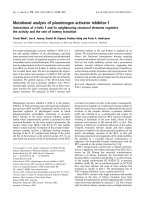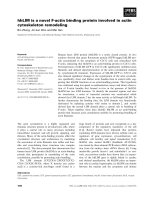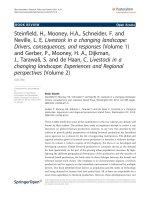numerical mathematics - a. quarteroni, a. sacco, f. saleri
Bạn đang xem bản rút gọn của tài liệu. Xem và tải ngay bản đầy đủ của tài liệu tại đây (4.14 MB, 669 trang )
Numerical Mathematics
Alfio Quarteroni
Riccardo Sacco
Fausto Saleri
Springer
Texts in Applied Mathematicsm37
Springer
New York
Berlin
Heidelberg
Barcelona
Hong Kong
London
Milan
Paris
Singapore
Tokyo
Editors
J.E. Marsden
L. Sirovich
M. Golubitsky
W. Jäger
Advisors
G. Iooss
P. Holmes
D. Barkley
M. Dellnitz
P. NewtonAlfio QuarteroniMMRiccardo Sacco
Fausto Saleri
123
Numerical Mathematics
With 134 Illustrations
Alfio Quarteroni
Department of Mathematics
Ecole Polytechnique
MFe´de´rale de Lausanne
CH-1015 Lausanne
Switzerland
Riccardo Sacco
Dipartimento di Matematica
Politecnico di Milano
Piazza Leonardo da Vinci 32
20133 Milan
Italy
Fausto Saleri
Dipartimento di Matematica,
M“F. Enriques”
Università degli Studi di
MMilano
Via Saldini 50
20133 Milan
Italy
Series Editors
J.E. Marsden
Control and Dynamical Systems, 107–81
California Institute of Technology
Pasadena, CA 91125
USA
M. Golubitsky
Department of Mathematics
University of Houston
Houston, TX 77204-3476
USA
L. Sirovich
Division of Applied Mathematics
Brown University
Providence, RI 02912
USA
W. J¨ager
Department of Applied Mathematics
Universit ¨at Heidelberg
Im Neuenheimer Feld 294
69120 Heidelberg
Germany
Library of Congress Cataloging-in-Publication Data
Quarteroni, Alfio.
Numerical mathematics/Alfio Quarteroni, Riccardo Sacco, Fausto Saleri.
p.Mcm. — (Texts in applied mathematics; 37)
Includes bibliographical references and index.
ISBN 0-387-98959-5 (alk. paper)
1. Numerical analysis.MI. Sacco, Riccardo.MII. Saleri, Fausto.MIII. Title.MIV. Series.
I. Title.MMII. Series.
QA297.Q83M2000
519.4—dc21 99-059414
© 2000 Springer-Verlag New York, Inc.
All rights reserved. This work may not be translated or copied in whole or in part without
the written permission of the publisher (Springer-Verlag New York, Inc., 175 Fifth Avenue,
New York, NY 10010, USA), except for brief excerpts in connection with reviews or scholarly
analysis. Use in connection with any form of information storage and retrieval, electronic
adaptation, computer software, or by similar or dissimilar methodology now known or heraf-
ter developed is forbidden.
The use of general descriptive names, trade names, trademarks, etc., in this publication, even
if the former are not especially identified, is not to be taken as a sign that such names, as
understood by the Trade Marks and Merchandise Marks Act, may accordingly be used freely
by anyone.
ISBN 0-387-98959-5nSpringer-VerlagnNew YorknBerlinnHeidelbergMSPIN 10747955
Mathematics Subject Classification (1991): 15-01, 34-01, 35-01, 65-01
Numerical mathematics is the branch of mathematics that proposes, de-
velops, analyzes and applies methods from scientific computing to several
fields including analysis, linear algebra, geometry, approximation theory,
functional equations, optimization and differential equations. Other disci-
plines such as physics, the natural and biological sciences, engineering, and
economics and the financial sciences frequently give rise to problems that
need scientific computing for their solutions.
As such, numerical mathematics is the crossroad of several disciplines of
great relevance in modern applied sciences, and can become a crucial tool
for their qualitative and quantitative analysis. This role is also emphasized
by the continual development of computers and algorithms, which make it
possible nowadays, using scientific computing, to tackle problems of such
a large size that real-life phenomena can be simulated providing accurate
responses at affordable computational cost.
The corresponding spread of numerical software represents an enrichment
for the scientific community. However, the user has to make the correct
choice of the method (or the algorithm) which best suits the problem at
hand. As a matter of fact, no black-box methods or algorithms exist that
can effectively and accurately solve all kinds of problems.
One of the purposes of this book is to provide the mathematical foun-
dations of numerical methods, to analyze their basic theoretical proper-
ties (stability, accuracy, computational complexity), and demonstrate their
performances on examples and counterexamples which outline their pros
viii Preface
and cons. This is done using the MATLAB
1
software environment. This
choice satisfies the two fundamental needs of user-friendliness and wide-
spread diffusion, making it available on virtually every computer.
Every chapter is supplied with examples, exercises and applications of
the discussed theory to the solution of real-life problems. The reader is
thus in the ideal condition for acquiring the theoretical knowledge that is
required to make the right choice among the numerical methodologies and
make use of the related computer programs.
This book is primarily addressed to undergraduate students, with partic-
ular focus on the degree courses in Engineering, Mathematics, Physics and
Computer Science. The attention which is paid to the applications and the
related development of software makes it valuable also for graduate stu-
dents, researchers and users of scientific computing in the most widespread
professional fields.
The content of the volume is organized into four parts and 13 chapters.
Part I comprises two chapters in which we review basic linear algebra and
introduce the general concepts of consistency, stability and convergence of
a numerical method as well as the basic elements of computer arithmetic.
Part II is on numerical linear algebra, and is devoted to the solution of
linear systems (Chapters 3 and 4) and eigenvalues and eigenvectors com-
putation (Chapter 5).
We continue with Part III where we face several issues about functions
and their approximation. Specifically, we are interested in the solution of
nonlinear equations (Chapter 6), solution of nonlinear systems and opti-
mization problems (Chapter 7), polynomial approximation (Chapter 8) and
numerical integration (Chapter 9).
Part IV, which is the more demanding as a mathematical background, is
concerned with approximation, integration and transforms based on orthog-
onal polynomials (Chapter 10), solution of initial value problems (Chap-
ter 11), boundary value problems (Chapter 12) and initial-boundary value
problems for parabolic and hyperbolic equations (Chapter 13).
Part I provides the indispensable background. Each of the remaining
Parts has a size and a content that make it well suited for a semester
course.
A guideline index to the use of the numerous MATLAB Programs de-
veloped in the book is reported at the end of the volume. These programs
are also available at the web site address:
/>For the reader’s ease, any code is accompanied by a brief description of
its input/output parameters.
We express our thanks to the staff at Springer-Verlag New York for their
expert guidance and assistance with editorial aspects, as well as to Dr.
1
MATLAB is a registered trademark of The MathWorks, Inc.
Preface ix
Martin Peters from Springer-Verlag Heidelberg and Dr. Francesca Bonadei
from Springer-Italia for their advice and friendly collaboration all along
this project.
We gratefully thank Professors L. Gastaldi and A. Valli for their useful
comments on Chapters 12 and 13.
We also wish to express our gratitude to our families for their forbearance
and understanding, and dedicate this book to them.
Lausanne, Switzerland Alfio Quarteroni
Milan, Italy Riccardo Sacco
Milan, Italy Fausto Saleri
January 2000
Contents
Series Preface v
Preface vii
PART I: Getting Started
1. Foundations of Matrix Analysis 1
1.1 Vector Spaces 1
1.2 Matrices 3
1.3 Operations with Matrices 5
1.3.1 Inverse of a Matrix 6
1.3.2 Matrices and Linear Mappings 7
1.3.3 Operations with Block-Partitioned Matrices 7
1.4 Trace and Determinant of a Matrix 8
1.5 Rank and Kernel of a Matrix 9
1.6 Special Matrices 10
1.6.1 Block Diagonal Matrices 10
1.6.2 Trapezoidal and Triangular Matrices 11
1.6.3 Banded Matrices 11
1.7 Eigenvalues and Eigenvectors 12
1.8 Similarity Transformations 14
1.9 The Singular Value Decomposition (SVD) 16
1.10 Scalar Product and Norms in Vector Spaces 17
1.11 Matrix Norms 21
xii Contents
1.11.1 Relation Between Norms and the
Spectral Radius of a Matrix 25
1.11.2 Sequences and Series of Matrices 26
1.12 Positive Definite, Diagonally Dominant and M-Matrices . 27
1.13 Exercises 30
2. Principles of Numerical Mathematics 33
2.1 Well-Posedness and Condition Number of a Problem . . . 33
2.2 Stability of Numerical Methods 37
2.2.1 Relations Between Stability and Convergence . . . 40
2.3 A priori and a posteriori Analysis 41
2.4 Sources of Error in Computational Models 43
2.5 Machine Representation of Numbers 45
2.5.1 The Positional System 45
2.5.2 The Floating-Point Number System 46
2.5.3 Distribution of Floating-Point Numbers 49
2.5.4 IEC/IEEE Arithmetic 49
2.5.5 Rounding of a Real Number in Its
Machine Representation 50
2.5.6 Machine Floating-Point Operations 52
2.6 Exercises 54
PART II: Numerical Linear Algebra
3. Direct Methods for the Solution of Linear Systems 57
3.1 Stability Analysis of Linear Systems 58
3.1.1 The Condition Number of a Matrix 58
3.1.2 Forward a priori Analysis 60
3.1.3 Backward a priori Analysis 63
3.1.4 A posteriori Analysis 64
3.2 Solution of Triangular Systems 65
3.2.1 Implementation of Substitution Methods 65
3.2.2 Rounding Error Analysis 67
3.2.3 Inverse of a Triangular Matrix 67
3.3 The Gaussian Elimination Method (GEM) and
LU Factorization 68
3.3.1 GEM as a Factorization Method 72
3.3.2 The Effect of Rounding Errors 76
3.3.3 Implementation of LU Factorization 77
3.3.4 Compact Forms of Factorization 78
3.4 Other Types of Factorization 79
3.4.1 LDM
T
Factorization 79
3.4.2 Symmetric and Positive Definite Matrices:
The Cholesky Factorization 80
3.4.3 Rectangular Matrices: The QR Factorization . . . 82
Contents xiii
3.5 Pivoting 85
3.6 Computing the Inverse of a Matrix 89
3.7 Banded Systems 90
3.7.1 Tridiagonal Matrices 91
3.7.2 Implementation Issues 92
3.8 Block Systems 93
3.8.1 Block LU Factorization 94
3.8.2 Inverse of a Block-Partitioned Matrix 95
3.8.3 Block Tridiagonal Systems 95
3.9 Sparse Matrices 97
3.9.1 The Cuthill-McKee Algorithm 98
3.9.2 Decomposition into Substructures 100
3.9.3 Nested Dissection 103
3.10 Accuracy of the Solution Achieved Using GEM 103
3.11 An Approximate Computation of K(A) 106
3.12 Improving the Accuracy of GEM 109
3.12.1 Scaling 110
3.12.2 Iterative Refinement 111
3.13 Undetermined Systems 112
3.14 Applications 115
3.14.1 Nodal Analysis of a Structured Frame 115
3.14.2 Regularization of a Triangular Grid 118
3.15 Exercises 121
4. Iterative Methods for Solving Linear Systems 123
4.1 On the Convergence of Iterative Methods 123
4.2 Linear Iterative Methods 126
4.2.1 Jacobi, Gauss-Seidel and Relaxation Methods . . . 127
4.2.2 Convergence Results for Jacobi and
Gauss-Seidel Methods 129
4.2.3 Convergence Results for the Relaxation Method . 131
4.2.4 A priori Forward Analysis 132
4.2.5 Block Matrices 133
4.2.6 Symmetric Form of the Gauss-Seidel and
SOR Methods 133
4.2.7 Implementation Issues 135
4.3 Stationary and Nonstationary Iterative Methods 136
4.3.1 Convergence Analysis of the Richardson Method . 137
4.3.2 Preconditioning Matrices 139
4.3.3 The Gradient Method 146
4.3.4 The Conjugate Gradient Method 150
4.3.5 The Preconditioned Conjugate Gradient Method . 156
4.3.6 The Alternating-Direction Method 158
4.4 Methods Based on Krylov Subspace Iterations 159
4.4.1 The Arnoldi Method for Linear Systems 162
xiv Contents
4.4.2 The GMRES Method 165
4.4.3 The Lanczos Method for Symmetric Systems . . . 167
4.5 The Lanczos Method for Unsymmetric Systems 168
4.6 Stopping Criteria 171
4.6.1 A Stopping Test Based on the Increment 172
4.6.2 A Stopping Test Based on the Residual 174
4.7 Applications 174
4.7.1 Analysis of an Electric Network 174
4.7.2 Finite Difference Analysis of Beam Bending 177
4.8 Exercises 179
5. Approximation of Eigenvalues and Eigenvectors 183
5.1 Geometrical Location of the Eigenvalues 183
5.2 Stability and Conditioning Analysis 186
5.2.1 A priori Estimates 186
5.2.2 A posteriori Estimates 190
5.3 The Power Method 192
5.3.1 Approximation of the Eigenvalue of
Largest Module 192
5.3.2 Inverse Iteration 195
5.3.3 Implementation Issues 196
5.4 The QR Iteration 200
5.5 The Basic QR Iteration 201
5.6 The QR Method for Matrices in Hessenberg Form 203
5.6.1 Householder and Givens Transformation Matrices 204
5.6.2 Reducing a Matrix in Hessenberg Form 207
5.6.3 QR Factorization of a Matrix in Hessenberg Form 209
5.6.4 The Basic QR Iteration Starting from
Upper Hessenberg Form 210
5.6.5 Implementation of Transformation Matrices 212
5.7 The QR Iteration with Shifting Techniques 215
5.7.1 The QR Method with Single Shift 215
5.7.2 The QR Method with Double Shift 218
5.8 Computing the Eigenvectors and the SVD of a Matrix . . 221
5.8.1 The Hessenberg Inverse Iteration 221
5.8.2 Computing the Eigenvectors from the
Schur Form of a Matrix 221
5.8.3 Approximate Computation of the SVD of a Matrix 222
5.9 The Generalized Eigenvalue Problem 224
5.9.1 Computing the Generalized Real Schur Form . . . 225
5.9.2 Generalized Real Schur Form of
Symmetric-Definite Pencils 226
5.10 Methods for Eigenvalues of Symmetric Matrices 227
5.10.1 The Jacobi Method 227
5.10.2 The Method of Sturm Sequences 230
Contents xv
5.11 The Lanczos Method 233
5.12 Applications 235
5.12.1 Analysis of the Buckling of a Beam 236
5.12.2 Free Dynamic Vibration of a Bridge 238
5.13 Exercises 240
PART III: Around Functions and Functionals
6. Rootfinding for Nonlinear Equations 245
6.1 Conditioning of a Nonlinear Equation 246
6.2 A Geometric Approach to Rootfinding 248
6.2.1 The Bisection Method 248
6.2.2 The Methods of Chord, Secant and Regula Falsi
and Newton’s Method 251
6.2.3 The Dekker-Brent Method 256
6.3 Fixed-Point Iterations for Nonlinear Equations 257
6.3.1 Convergence Results for
Some Fixed-Point Methods 260
6.4 Zeros of Algebraic Equations 261
6.4.1 The Horner Method and Deflation 262
6.4.2 The Newton-Horner Method 263
6.4.3 The Muller Method 267
6.5 Stopping Criteria 269
6.6 Post-Processing Techniques for Iterative Methods 272
6.6.1 Aitken’s Acceleration 272
6.6.2 Techniques for Multiple Roots 275
6.7 Applications 276
6.7.1 Analysis of the State Equation for a Real Gas . . 276
6.7.2 Analysis of a Nonlinear Electrical Circuit 277
6.8 Exercises 279
7. Nonlinear Systems and Numerical Optimization 281
7.1 Solution of Systems of Nonlinear Equations 282
7.1.1 Newton’s Method and Its Variants 283
7.1.2 Modified Newton’s Methods 284
7.1.3 Quasi-Newton Methods 288
7.1.4 Secant-Like Methods 288
7.1.5 Fixed-Point Methods 290
7.2 Unconstrained Optimization 294
7.2.1 Direct Search Methods 295
7.2.2 Descent Methods 300
7.2.3 Line Search Techniques 302
7.2.4 Descent Methods for Quadratic Functions 304
7.2.5 Newton-Like Methods for Function Minimization . 307
7.2.6 Quasi-Newton Methods 308
xvi Contents
7.2.7 Secant-Like Methods 309
7.3 Constrained Optimization 311
7.3.1 Kuhn-Tucker Necessary Conditions for
Nonlinear Programming 313
7.3.2 The Penalty Method 315
7.3.3 The Method of Lagrange Multipliers 317
7.4 Applications 319
7.4.1 Solution of a Nonlinear System Arising from
Semiconductor Device Simulation 320
7.4.2 Nonlinear Regularization of a Discretization Grid . 323
7.5 Exercises 325
8. Polynomial Interpolation 327
8.1 Polynomial Interpolation 328
8.1.1 The Interpolation Error 329
8.1.2 Drawbacks of Polynomial Interpolation on Equally
Spaced Nodes and Runge’s Counterexample 330
8.1.3 Stability of Polynomial Interpolation 332
8.2 Newton Form of the Interpolating Polynomial 333
8.2.1 Some Properties of Newton Divided Differences . . 335
8.2.2 The Interpolation Error Using Divided Differences 337
8.3 Piecewise Lagrange Interpolation 338
8.4 Hermite-Birkoff Interpolation 341
8.5 Extension to the Two-Dimensional Case 343
8.5.1 Polynomial Interpolation 343
8.5.2 Piecewise Polynomial Interpolation 344
8.6 Approximation by Splines 348
8.6.1 Interpolatory Cubic Splines 349
8.6.2 B-Splines 353
8.7 Splines in Parametric Form 357
8.7.1 B´ezier Curves and Parametric B-Splines 359
8.8 Applications 362
8.8.1 Finite Element Analysis of a Clamped Beam . . . 363
8.8.2 Geometric Reconstruction Based on
Computer Tomographies 366
8.9 Exercises 368
9. Numerical Integration 371
9.1 Quadrature Formulae 371
9.2 Interpolatory Quadratures 373
9.2.1 The Midpoint or Rectangle Formula 373
9.2.2 The Trapezoidal Formula 375
9.2.3 The Cavalieri-Simpson Formula 377
9.3 Newton-Cotes Formulae 378
9.4 Composite Newton-Cotes Formulae 383
Contents xvii
9.5 Hermite Quadrature Formulae 386
9.6 Richardson Extrapolation 387
9.6.1 Romberg Integration 389
9.7 Automatic Integration 391
9.7.1 Non Adaptive Integration Algorithms 392
9.7.2 Adaptive Integration Algorithms 394
9.8 Singular Integrals 398
9.8.1 Integrals of Functions with Finite
Jump Discontinuities 398
9.8.2 Integrals of Infinite Functions 398
9.8.3 Integrals over Unbounded Intervals 401
9.9 Multidimensional Numerical Integration 402
9.9.1 The Method of Reduction Formula 403
9.9.2 Two-Dimensional Composite Quadratures 404
9.9.3 Monte Carlo Methods for
Numerical Integration 407
9.10 Applications 408
9.10.1 Computation of an Ellipsoid Surface 408
9.10.2 Computation of the Wind Action on a
Sailboat Mast 410
9.11 Exercises 412
PART IV: Transforms, Differentiation
and Problem Discretization
10. Orthogonal Polynomials in Approximation Theory 415
10.1 Approximation of Functions by Generalized Fourier Series 415
10.1.1 The Chebyshev Polynomials 417
10.1.2 The Legendre Polynomials 419
10.2 Gaussian Integration and Interpolation 419
10.3 Chebyshev Integration and Interpolation 424
10.4 Legendre Integration and Interpolation 426
10.5 Gaussian Integration over Unbounded Intervals 428
10.6 Programs for the Implementation of Gaussian Quadratures 429
10.7 Approximation of a Function in the Least-Squares Sense . 431
10.7.1 Discrete Least-Squares Approximation 431
10.8 The Polynomial of Best Approximation 433
10.9 Fourier Trigonometric Polynomials 435
10.9.1 The Gibbs Phenomenon 439
10.9.2 The Fast Fourier Transform 440
10.10 Approximation of Function Derivatives 442
10.10.1 Classical Finite Difference Methods 442
10.10.2 Compact Finite Differences 444
10.10.3 Pseudo-Spectral Derivative 448
10.11 Transforms and Their Applications 450
xviii Contents
10.11.1 The Fourier Transform 450
10.11.2 (Physical) Linear Systems and Fourier Transform . 453
10.11.3 The Laplace Transform 455
10.11.4 The Z-Transform 457
10.12 The Wavelet Transform 458
10.12.1 The Continuous Wavelet Transform 458
10.12.2 Discrete and Orthonormal Wavelets 461
10.13 Applications 463
10.13.1 Numerical Computation of Blackbody Radiation . 463
10.13.2 Numerical Solution of Schr¨odinger Equation 464
10.14 Exercises 467
11. Numerical Solution of Ordinary Differential Equations 469
11.1 The Cauchy Problem 469
11.2 One-Step Numerical Methods 472
11.3 Analysis of One-Step Methods 473
11.3.1 The Zero-Stability 475
11.3.2 Convergence Analysis 477
11.3.3 The Absolute Stability 479
11.4 Difference Equations 482
11.5 Multistep Methods 487
11.5.1 Adams Methods 490
11.5.2 BDF Methods 492
11.6 Analysis of Multistep Methods 492
11.6.1 Consistency 493
11.6.2 The Root Conditions 494
11.6.3 Stability and Convergence Analysis for
Multistep Methods 495
11.6.4 Absolute Stability of Multistep Methods 499
11.7 Predictor-Corrector Methods 502
11.8 Runge-Kutta Methods 508
11.8.1 Derivation of an Explicit RK Method 511
11.8.2 Stepsize Adaptivity for RK Methods 512
11.8.3 Implicit RK Methods 514
11.8.4 Regions of Absolute Stability for RK Methods . . 516
11.9 Systems of ODEs 517
11.10 Stiff Problems 519
11.11 Applications 521
11.11.1 Analysis of the Motion of a Frictionless Pendulum 522
11.11.2 Compliance of Arterial Walls 523
11.12 Exercises 527
12. Two-Point Boundary Value Problems 531
12.1 A Model Problem 531
12.2 Finite Difference Approximation 533
Contents xix
12.2.1 Stability Analysis by the Energy Method 534
12.2.2 Convergence Analysis 538
12.2.3 Finite Differences for Two-Point Boundary
Value Problems with Variable Coefficients 540
12.3 The Spectral Collocation Method 542
12.4 The Galerkin Method 544
12.4.1 Integral Formulation of Boundary-Value Problems 544
12.4.2 A Quick Introduction to Distributions 546
12.4.3 Formulation and Properties of the
Galerkin Method 547
12.4.4 Analysis of the Galerkin Method 548
12.4.5 The Finite Element Method 550
12.4.6 Implementation Issues 556
12.4.7 Spectral Methods 559
12.5 Advection-Diffusion Equations 560
12.5.1 Galerkin Finite Element Approximation 561
12.5.2 The Relationship Between Finite Elements and
Finite Differences; the Numerical Viscosity 563
12.5.3 Stabilized Finite Element Methods 567
12.6 A Quick Glance to the Two-Dimensional Case 572
12.7 Applications 575
12.7.1 Lubrication of a Slider 575
12.7.2 Vertical Distribution of Spore
Concentration over Wide Regions 576
12.8 Exercises 578
13. Parabolic and Hyperbolic Initial Boundary
Value Problems 581
13.1 The Heat Equation 581
13.2 Finite Difference Approximation of the Heat Equation . . 584
13.3 Finite Element Approximation of the Heat Equation . . . 586
13.3.1 Stability Analysis of the θ-Method 588
13.4 Space-Time Finite Element Methods for the
Heat Equation 593
13.5 Hyperbolic Equations: A Scalar Transport Problem 597
13.6 Systems of Linear Hyperbolic Equations 599
13.6.1 The Wave Equation 601
13.7 The Finite Difference Method for Hyperbolic Equations . . 602
13.7.1 Discretization of the Scalar Equation 602
13.8 Analysis of Finite Difference Methods 605
13.8.1 Consistency 605
13.8.2 Stability 605
13.8.3 The CFL Condition 606
13.8.4 Von Neumann Stability Analysis 608
13.9 Dissipation and Dispersion 611
xx Contents
13.9.1 Equivalent Equations 614
13.10 Finite Element Approximation of Hyperbolic Equations . . 618
13.10.1 Space Discretization with Continuous and
Discontinuous Finite Elements 618
13.10.2 Time Discretization 620
13.11 Applications 623
13.11.1 Heat Conduction in a Bar 623
13.11.2 A Hyperbolic Model for Blood Flow
Interaction with Arterial Walls 623
13.12 Exercises 625
References 627
Index of MATLAB Programs 643
Index 647
1
Foundations of Matrix Analysis
In this chapter we recall the basic elements of linear algebra which will be
employed in the remainder of the text. For most of the proofs as well as
for the details, the reader is referred to [Bra75], [Nob69], [Hal58]. Further
results on eigenvalues can be found in [Hou75] and [Wil65].
1.1 Vector Spaces
Definition 1.1 A vector space over the numeric field K (K = R or K = C)
is a nonempty set V , whose elements are called vectors and in which two
operations are defined, called addition and scalar multiplication, that enjoy
the following properties:
1. addition is commutative and associative;
2. there exists an element 0 ∈ V (the zero vector or null vector) such
that v + 0 = v for each v ∈ V ;
3. 0 · v = 0,1· v = v, where 0 and 1 are respectively the zero and the
unity of K;
4. for each element v ∈ V there exists its opposite, −v,inV such that
v +(−v)=0;
2 1. Foundations of Matrix Analysis
5. the following distributive properties hold
∀α ∈ K, ∀v, w ∈ V, α(v + w)=αv + αw,
∀α, β ∈ K, ∀v ∈ V, (α + β)v = αv + βv;
6. the following associative property holds
∀α, β ∈ K, ∀v ∈ V, (αβ)v = α(βv).
Example 1.1 Remarkable instances of vector spaces are:
- V = R
n
(respectively V = C
n
): the set of the n-tuples of real (respectively
complex) numbers, n ≥ 1;
- V = P
n
: the set of polynomials p
n
(x)=
n
k=0
a
k
x
k
with real (or complex)
coefficients a
k
having degree less than or equal to n, n ≥ 0;
- V = C
p
([a, b]): the set of real (or complex)-valued functions which are con-
tinuous on [a, b] up to their p-th derivative, 0 ≤ p<∞. •
Definition 1.2 We say that a nonempty part W of V is a vector subspace
of V iff W is a vector space over K.
Example 1.2 The vector space P
n
is a vector subspace of C
∞
(R), which is the
space of infinite continuously differentiable functions on the real line. A trivial
subspace of any vector space is the one containing only the zero vector. •
In particular, the set W of the linear combinations of a system of p vectors
of V , {v
1
, ,v
p
}, is a vector subspace of V , called the generated subspace
or span of the vector system, and is denoted by
W = span {v
1
, ,v
p
}
= {v = α
1
v
1
+ + α
p
v
p
with α
i
∈ K, i =1, ,p}.
The system {v
1
, ,v
p
} is called a system of generators for W.
If W
1
, ,W
m
are vector subspaces of V , then the set
S = {w : w = v
1
+ + v
m
with v
i
∈ W
i
,i=1, ,m}
is also a vector subspace of V . We say that S is the direct sum of the
subspaces W
i
if any element s ∈ S admits a unique representation of the
form s = v
1
+ + v
m
with v
i
∈ W
i
and i =1, ,m. In such a case, we
shall write S = W
1
⊕ ⊕ W
m
.
1.2 Matrices 3
Definition 1.3 A system of vectors {v
1
, ,v
m
} of a vector space V is
called linearly independent if the relation
α
1
v
1
+ α
2
v
2
+ + α
m
v
m
= 0
with α
1
,α
2
, ,α
m
∈ K implies that α
1
= α
2
= = α
m
= 0. Otherwise,
the system will be called linearly dependent.
We call a basis of V any system of linearly independent generators of V .
If {u
1
, ,u
n
} is a basis of V , the expression v = v
1
u
1
+ + v
n
u
n
is
called the decomposition of v with respect to the basis and the scalars
v
1
, ,v
n
∈ K are the components of v with respect to the given basis.
Moreover, the following property holds.
Property 1.1 Let V be a vector space which admits a basis of n vectors.
Then every system of linearly independent vectors of V has at most n el-
ements and any other basis of V has n elements. The number n is called
the dimension of V and we write dim(V )=n.
If, instead, for any n there always exist n linearly independent vectors of
V , the vector space is called infinite dimensional.
Example 1.3 For any integer p the space C
p
([a, b]) is infinite dimensional. The
spaces R
n
and C
n
have dimension equal to n. The usual basis for R
n
is the set of
unit vectors {e
1
, ,e
n
} where (e
i
)
j
= δ
ij
for i, j =1, n, where δ
ij
denotes
the Kronecker symbol equal to 0 if i = j and1ifi = j. This choice is of course
not the only one that is possible (see Exercise 2). •
1.2 Matrices
Let m and n be two positive integers. We call a matrix having m rows and
n columns, or a matrix m × n, or a matrix (m, n), with elements in K,a
set of mn scalars a
ij
∈ K, with i =1, ,m and j =1, n, represented
in the following rectangular array
A=
a
11
a
12
a
1n
a
21
a
22
a
2n
.
.
.
.
.
.
.
.
.
a
m1
a
m2
a
mn
. (1.1)
When K = R or K = C we shall respectively write A ∈ R
m×n
or A ∈
C
m×n
, to explicitly outline the numerical fields which the elements of A
belong to. Capital letters will be used to denote the matrices, while the
lower case letters corresponding to those upper case letters will denote the
matrix entries.
4 1. Foundations of Matrix Analysis
We shall abbreviate (1.1) as A = (a
ij
) with i =1, ,m and j =1, n.
The index i is called row index, while j is the column index. The set
(a
i1
,a
i2
, ,a
in
) is called the i-th row of A; likewise, (a
1j
,a
2j
, ,a
mj
)
is the j-th column of A.
If n = m the matrix is called squared or having order n and the set of
the entries (a
11
,a
22
, ,a
nn
) is called its main diagonal.
A matrix having one row or one column is called a row vector or column
vector respectively. Unless otherwise specified, we shall always assume that
a vector is a column vector. In the case n = m = 1, the matrix will simply
denote a scalar of K.
Sometimes it turns out to be useful to distinguish within a matrix the set
made up by specified rows and columns. This prompts us to introduce the
following definition.
Definition 1.4 Let A be a matrix m ×n. Let 1 ≤ i
1
<i
2
< <i
k
≤ m
and 1 ≤ j
1
<j
2
< <j
l
≤ n two sets of contiguous indexes. The matrix
S(k × l) of entries s
pq
= a
i
p
j
q
with p =1, ,k, q =1, ,l is called a
submatrix of A. If k = l and i
r
= j
r
for r =1, ,k, S is called a principal
submatrix of A.
Definition 1.5 A matrix A(m × n) is called block partitioned or said to
be partitioned into submatrices if
A=
A
11
A
12
A
1l
A
21
A
22
A
2l
.
.
.
.
.
.
.
.
.
.
.
.
A
k1
A
k2
A
kl
,
where A
ij
are submatrices of A.
Among the possible partitions of A, we recall in particular the partition by
columns
A=(a
1
, a
2
, ,a
n
),
a
i
being the i-th column vector of A. In a similar way the partition by rows
of A can be defined. To fix the notations, if A is a matrix m × n, we shall
denote by
A(i
1
: i
2
,j
1
: j
2
)=(a
ij
) i
1
≤ i ≤ i
2
,j
1
≤ j ≤ j
2
the submatrix of A of size (i
2
−i
1
+1)×(j
2
−j
1
+ 1) that lies between the
rows i
1
and i
2
and the columns j
1
and j
2
. Likewise, if v is a vector of size
n, we shall denote by v(i
1
: i
2
) the vector of size i
2
− i
1
+ 1 made up by
the i
1
-th to the i
2
-th components of v.
These notations are convenient in view of programming the algorithms
that will be presented throughout the volume in the MATLAB language.
1.3 Operations with Matrices 5
1.3 Operations with Matrices
Let A = (a
ij
) and B = (b
ij
) be two matrices m ×n over K. We say that
Aisequal to B, if a
ij
= b
ij
for i =1, ,m, j =1, ,n. Moreover, we
define the following operations:
- matrix sum: the matrix sum is the matrix A+B = (a
ij
+b
ij
). The neutral
element in a matrix sum is the null matrix, still denoted by 0 and
made up only by null entries;
- matrix multiplication by a scalar: the multiplication of A by λ ∈ K,isa
matrix λA=(λa
ij
);
- matrix product: the product of two matrices A and B of sizes (m, p)
and (p, n) respectively, is a matrix C(m, n) whose entries are c
ij
=
p
k=1
a
ik
b
kj
, for i =1, ,m, j =1, ,n.
The matrix product is associative and distributive with respect to the ma-
trix sum, but it is not in general commutative. The square matrices for
which the property AB = BA holds, will be called commutative.
In the case of square matrices, the neutral element in the matrix product
is a square matrix of order n called the unit matrix of order n or, more
frequently, the identity matrix given by I
n
=(δ
ij
). The identity matrix
is, by definition, the only matrix n × n such that AI
n
=I
n
A = A for all
square matrices A. In the following we shall omit the subscript n unless it
is strictly necessary. The identity matrix is a special instance of a diagonal
matrix of order n, that is, a square matrix of the type D = (d
ii
δ
ij
). We will
use in the following the notation D = diag(d
11
,d
22
, ,d
nn
).
Finally, if A is a square matrix of order n and p is an integer, we define A
p
as the product of A with itself iterated p times. We let A
0
=I.
Let us now address the so-called elementary row operations that can be
performed on a matrix. They consist of:
- multiplying the i-th row of a matrix by a scalar α; this operation is
equivalent to pre-multiplying A by the matrix D = diag(1, ,1,α,
1, ,1), where α occupies the i-th position;
- exchanging the i-th and j-th rows of a matrix; this can be done by pre-
multiplying A by the matrix P
(i,j)
of elements
p
(i,j)
rs
=
1ifr = s =1, ,i− 1,i+1, ,j− 1,j+1, n,
1ifr = j, s = i or r = i, s = j,
0 otherwise,
(1.2)
6 1. Foundations of Matrix Analysis
where I
r
denotes the identity matrix of order r = j − i − 1ifj>
i (henceforth, matrices with size equal to zero will correspond to
the empty set). Matrices like (1.2) are called elementary permutation
matrices. The product of elementary permutation matrices is called
a permutation matrix, and it performs the row exchanges associated
with each elementary permutation matrix. In practice, a permutation
matrix is a reordering by rows of the identity matrix;
- adding α times the j-th row of a matrix to its i-th row. This operation
can also be performed by pre-multiplying A by the matrix I + N
(i,j)
α
,
where N
(i,j)
α
is a matrix having null entries except the one in position
i, j whose value is α.
1.3.1 Inverse of a Matrix
Definition 1.6 A square matrix A of order n is called invertible (or regular
or nonsingular) if there exists a square matrix B of order n such that
A B = B A = I. B is called the inverse matrix of A and is denoted by A
−1
.
A matrix which is not invertible is called singular.
If A is invertible its inverse is also invertible, with (A
−1
)
−1
= A. Moreover,
if A and B are two invertible matrices of order n, their product AB is also
invertible, with (A B)
−1
=B
−1
A
−1
. The following property holds.
Property 1.2 A square matrix is invertible iff its column vectors are lin-
early independent.
Definition 1.7 We call the transpose of a matrix A∈ R
m×n
the matrix
n ×m, denoted by A
T
, that is obtained by exchanging the rows of A with
the columns of A.
Clearly, (A
T
)
T
=A,(A+B)
T
=A
T
+B
T
, (AB)
T
=B
T
A
T
and (αA)
T
=
αA
T
∀α ∈ R. If A is invertible, then also (A
T
)
−1
=(A
−1
)
T
=A
−T
.
Definition 1.8 Let A ∈ C
m×n
; the matrix B = A
H
∈ C
n×m
is called the
conjugate transpose (or adjoint)ofAifb
ij
=¯a
ji
, where ¯a
ji
is the complex
conjugate of a
ji
.
In analogy with the case of the real matrices, it turns out that (A+B)
H
=
A
H
+B
H
, (AB)
H
=B
H
A
H
and (αA)
H
=¯αA
H
∀α ∈ C.
Definition 1.9 A matrix A ∈ R
n×n
is called symmetric ifA=A
T
, while
it is antisymmetric if A = −A
T
. Finally, it is called orthogonal if A
T
A=
AA
T
= I, that is A
−1
=A
T
.
Permutation matrices are orthogonal and the same is true for their prod-
ucts.









